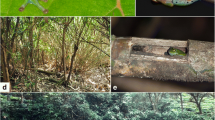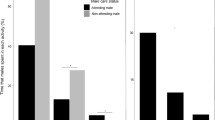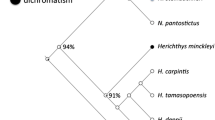Abstract
Parental care is important for offspring success for many animals. Both male-only and female-only care occur equally often among frogs, creating opportunities to examine ecological factors that may favor sex-specific patterns of care. Experimental tests of care function can elucidate such factors and identify benefits of parental behavior to offspring. In glassfrogs (Centrolenidae), only male egg attendance has been documented and male care is thought to have evolved repeatedly from a state of no-care. We provide experimental evidence demonstrating female care in the glassfrog Ikakogi tayrona—a species sister to all other members of the family. We used repeated observations to quantify egg attendance behaviors, and a removal experiment to evaluate the benefits of maternal care and test whether care function changes with embryonic development. Given the importance of care to female fitness, we examined maternal commitment to providing care in risky situations, using a simple behavioral challenge. We found that egg attendance reduces embryo dehydration and predation. Moreover, the specific benefits of care changed across embryo development, suggesting that different threats to embryos select for egg attendance at different stages. The maternal commitment assay revealed that caring females are more risk-tolerant than non-caring females. Our finding of maternal care in I. tayrona reveals previously unknown diversity in glassfrog parental care and contributes to emerging evidence that care functions are similar among frogs with female-only and male-only egg attendance. This suggests that a lack of sex-specific constraints may have facilitated evolutionary changes in sex roles.




Similar content being viewed by others
References
Alonso-Alvarez C, Velando A (2012) Benefits and costs of parental care. In: Royle NJ, Smiseth PT, Kölliker M (eds) The evolution of parental care. Oxford University Press, Oxford, pp 40–61
Balshine S (2012) Patterns of parental care in vertebrates. In: Royle NJ, Smiseth PT, Kölliker M (eds) The evolution of parental care. Oxford University Press, Oxford, pp 40–61
Bee MA, Schwartz JJ, Summers K (2013) All’s well that begins Wells: celebrating 60 years of Animal Behaviour and 36 years of research on anuran social behaviour. Anim Behav 85:5–18
Bickford DP (2004) Differential parental care behaviors of arboreal and terrestrial microhylid frogs from Papua New Guinea. Behav Ecol Sociobiol 55:402–409
Brown JL, Morales V, Summers K (2010) A key ecological trait drove the evolution of biparental care and monogamy in an amphibian. Am Nat 175:436–446
Cockburn A (2006) Prevalence of different modes of parental care in birds. Proc R Soc Lond B 273:1375–1383
Cook CL, Ferguson JWH, Telford SR (2001) Adaptive male parental care in the giant bullfrog, Pyxicephalus adspersus. J Herpetol 35:310–315
Clutton-Brock T (1991) The evolution of parental care. Princeton University Press, Princeton
Davison AC, Hinkley DV (1997) Bootstrap methods and their applications. Cambridge University Press, New York
Delia JR, Ramírez-Bautista A, Summers K (2013) Parents adjust care in response to weather conditions and egg dehydration in a neotropical glassfrog. Behav Ecol Sociobiol 67:557–569
Delia JR, Ramírez-Bautista A, Summers K (2014) Glassfrog embryos hatch early after parental desertion. Proc R Soc B 281:2013–3237
Frid A, Dill L (2002) Human-caused disturbance stimuli as a form of predation risk. Conserv Ecol 6:11
Gomez-Mestre I, Pyron RA, Wiens JJ (2012) Phylogenetic analyses reveal unexpected patterns in the evolution of reproductive modes in frogs. Evolution 66:3687–3700
Guayasamin JM, Castroviejo-Fisher S, Trueb L, Ayarzagüena J, Rada M, Vilà C (2009) Phylogenetic systematics of glassfrogs (Amphibia: Centrolenidae) and their sister taxon Allophryne ruthveni. Zootaxa 2100:1–97
Hawley TJ (2006) Embryonic development and mortality in Hyalinobatrachium pulveratum (Anura: Centrolenidae) of south-western Costa Rica. J Trop Ecol 22:731–734
Hayes MP (1983a) A technique for partitioning hatching and mortality estimates in leaf-breeding frogs. Herpetol Rev 14:115–116
Hayes MP (1983b) Predation on the adults and prehatching stages of glass frogs (Centrolenidae). Biotropica 15:74–76
Hurme K (2011) Tadpole schooling and parental care in the neotropical frog, Leptodactylus insularum. PhD Dissertation, University of Connecticut, Connecticut, USA
Jacobson SK (1985) Reproductive behavior and male mating success in two species of glass frogs (Centrolenidae). Herpetologica 41:396–404
Klug H, Alonzo SH, Bonsall MB (2012) Theoretical foundations of parental care. In: Royle NJ, Smiseth PT, Kölliker M (eds) The evolution of parental care. Oxford University Press, Oxford, pp 21–39
Kokko H, Jennions MD (2008) Parental investment, sexual selection and sex ratios. J Evol Biol 21:919–948
Lehtinen RM, Green SE, Pringle JL (2014) Impacts of paternal care and seasonal change on offspring survival: a multiseason experimental study of a Caribbean frog. Ethology 120:400–409
Lesnoff M, Lancelot R (2015) aod: analysis of overdispersed data. R package, version 1.3, http://cran.r-project.org/package=aod
Martins M, Pombal JP, Haddad CF (1998) Escalated aggressive behaviour and facultative parental care in the nest building gladiator frog, Hyla faber. Amphibia-Reptilia 19:65–73
McDiarmid RW (1978) Evolution of parental care in frogs. In: Burghardt GM, Bekoff M (eds) The development of behavior: comparative and evolutionary aspects. Garland, New York, pp 127–147
Poo S, Bickford DP (2013) The adaptive significance of egg attendance in a south‐east Asian tree frog. Ethology 119:671–679
R Development Core Team (2013) R: A Language and Environment for Statistical Computing. R Foundation for Statistical Computing, Vienna, Austria, https://www.r-project.org/
Reynolds JD, Goodwin NB, Freckleton RP (2002) Evolutionary transitions in parental care and live bearing in vertebrates. Philos T Roy Soc B 357:269–281
Rodrigues AP, Giaretta AA, da Silva DR, Facure KG (2011) Reproductive features of three maternal-caring species of Leptodactylus (Anura: Leptodactylidae) with a report on alloparental care in frogs. J Nat Hist 45:2037–2047
Ruiz-Carranza PM, Lynch JD (1991) Ranas Centrolenidae de Colombia II. Nuevas especies de Centrolene de la Cordillera Oriental y Sierra Nevada de Santa Marta. Lozania 58:1–26
Shine R (1988) Parental care in reptiles. In: Gans C, Huey RB (eds) Biology of the Reptilia, vol 16, Ecology B: Defense and Life History. AR Liss, New York, pp 275–329
Simon MP (1983) The ecology of parental care in a terrestrial breeding frog from New Guinea. Behav Ecol Sociobiol 14:61–67
Summers K, Tumulty J (2014) Parental care, sexual selection, and mating systems in neotropical poison frogs. In: Macedo HR, Machado G (eds) Sexual selection: perspectives and models from the neotropics. Academic Press, New York, pp 289–320
Townsend DS, Stewart MM, Pough FH (1984) Male parental care and its adaptive significance in a neotropical frog. Anim Behav 32:421–431
Trivers RL (1972) Parental investment and sexual selection. In: Campbell BG (ed) Sexual selection and the descent of man. Aldine‐Atherton, Chicago, pp 136–179
Valencia-Aguilar A, Castro-Herrera F, Ramírez-Pinilla MP (2012) Microhabitats for oviposition and male clutch attendance in Hyalinobatrachium aureoguttatum (Anura: Centrolenidae). Copeia 2012:722–731
Vargas-Salinas F, Bravo-Valencia L, Amézquita A (2015) The advertisement call and calling site of the early diverging glassfrog Ikakogi tayrona (Anura: Centrolenidae). South Am J Herpetol 10:65–70
Vargas-Salinas F, Quintero-Ángel A, Osorio-Domínguez D, Rojas-Morales JA, Escobar-Lasso S, Gutiérrez-Cárdenas PDA, Amézquita A (2014) Breeding and parental behaviour in the glass frog Centrolene savagei (Anura: Centrolenidae). J Nat His 48:1689–1705
Vockenhuber EA, Hödl W, Amézquita A (2009) Glassy fathers do matter: egg attendance enhances embryonic survivorship in the glass frog Hyalinobatrachium valerioi. J Herpetol 43:340–344
Walke JB, Harris RN, Reinert LK, Rollins‐Smith LA, Woodhams DC (2011) Social immunity in amphibians: evidence for vertical transmission of innate defenses. Biotropica 43:396–400
Warkentin KM (2000) Wasp predation and wasp-induced hatching of red-eyed treefrog eggs. Anim Behav 60:503–510
Wells KD (2007) The Ecology and Behavior of Amphibians. University of Chicago Press, Chicago, Illinois
Williams CG (1975) Sex and Evolution. Princeton University Press, Princeton
Acknowledgments
We thank K.M. Warkentin and J.C. Touchon for assisting with methods development and statistical analyses, and for critical reviews on multiple drafts of this manuscript. A. Amézquita, J.M. Guayasamin, P. Stevenson, and the Egg Science discussion group at Boston University provided thoughtful suggestions on an earlier version of this manuscript. Thanks to the Associate Editor and two anonymous reviewers for helpful comments that improved our manuscript. A. Amézquita supervised LBV’s thesis work at Universidad de los Andes. Partial funding was provided by Facultad de Ciencias at Universidad de los Andes and a Fullbright Fellowship. Special thanks to residents of La Tagua, especially Edelmira Prado and her family, for hosting us during field work. Permits were provided by Autoridad Nacional de Licencias Ambientales ANLA (Expediente IDB 0337).
Author information
Authors and Affiliations
Corresponding author
Ethics declarations
Conflict of interest
The authors declare that they have no conflict of interest.
Ethical approval
All applicable international, national, and/or institutional guidelines for the care and use of animals were followed. All procedures performed in studies involving animals were in accordance with the ethical standards of the Universidad de Los Andes and the Colombian Government; research was approved and permits were provided by the Autoridad Nacional de Licencias Ambientales (Expediente IDB 0337).
Additional information
Communicated by K. Summers
Electronic supplementary material
Below is the link to the electronic supplementary material.
ESM 1
(WMV 161503 kb)
Rights and permissions
About this article
Cite this article
Valencia, L.B., Delia, J. Maternal care in a glassfrog: care function and commitment to offspring in Ikakogi tayrona . Behav Ecol Sociobiol 70, 41–48 (2016). https://doi.org/10.1007/s00265-015-2022-x
Received:
Revised:
Accepted:
Published:
Issue Date:
DOI: https://doi.org/10.1007/s00265-015-2022-x




